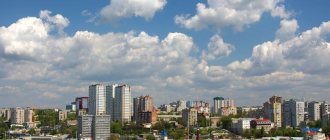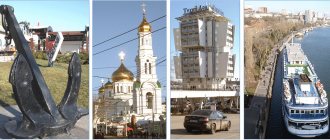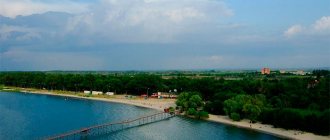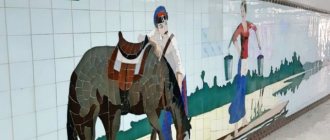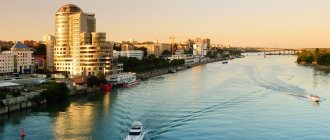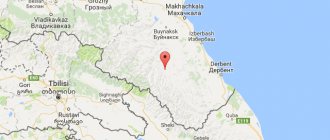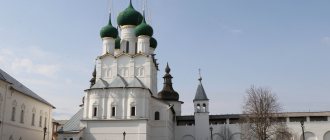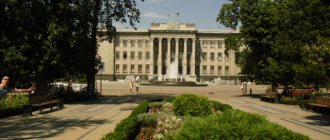Rostov-on-Don
Rostov-on-Don is the capital of the Don region and the Southern Federal District
Symbolism
| Flag | Coat of arms |
Administration
346007, Rostov-on-Don, Bolshaya Sadovaya st., 47
tel., fax
Housing and communal services hotline
Head of the city administration
Logvinenko Alexey Valentinovich
Chairman of the City Duma - mayor of the city
Zinaida Vasilievna Neyarokhina
Geography
Rostov-on-Don is the administrative center of the Rostov region and the Southern Federal District of Russia with a population of more than 1 million people.
The city is located in the southeast of the East European Plain, on the banks of the Don River, 46 km from its confluence with the Sea of Azov, in the center of transport routes providing access to three seas - the Black, Azov, Caspian - and direct contacts with the entire European part of the CIS, Transcaucasia, the Middle East and the Mediterranean. The area of the city is 348.5 sq. km, the distance to Moscow is 1076 km.
Story
The founding date of Rostov-on-Don is considered to be 1749, when the Russian Empress Elizaveta Petrovna signed a Decree establishing a state customs office at the mouth of the Temernik River. After this, a port appeared here, and in 1761 the construction of the military fortress of St. Demetrius of Rostov began. The favorable geographical position contributed to the economic development of Rostov. By its 100th anniversary, the city had about 15 thousand inhabitants, and by the 20th century over 110 thousand people lived in it. The basis of the economy of Rostov-on-Don was trade, and the city itself was called a merchant city. However, by the beginning of the 20th century, there were already more than 100 enterprises operating in it, every third of which belonged to foreign capital. Until 1917, Rostov-on-Don was the third city in Russia in terms of foreign trade turnover. By the end of the 30s, in terms of population and level of economic development, it was one of the ten largest cities in the Soviet Union.
Rostov-on-Don entered the heroic chronicle of the Great Patriotic War as a city where the Red Army went from defense to offensive. Rostov-on-Don was a strategic goal in the plans of the fascist command - it was not for nothing that Goebbels called it “the gates of the Caucasus.” But it was here, at the “gates of the Caucasus,” in November 1941 that the Wehrmacht suffered its first major defeat. During the occupation of the city, the Nazis shot and tortured tens of thousands of civilians, and drove about 50 thousand people into slavery. The central areas of the city were turned into ruins, the buildings of theaters, institutes, schools and hospitals were blown up and burned. Of the 270 factories and factories, only six survived. However, thanks to the dedicated work of Rostovites, the capital of the Don was restored from ruins and became even more beautiful.
In 1970, by Decree of the Supreme Soviet of the USSR, the city of Rostov-on-Don was awarded the Order of Lenin; in 1982, by Decree of the Presidium of the Supreme Soviet of the USSR, it was awarded the Order of the Patriotic War, 1st degree. On the eve of the celebration of the 63rd anniversary of Victory in the Great Patriotic War, Rostov-on-Don was awarded the honorary title “City of Military Glory”. Today Rostov-on-Don is one of the largest megacities of modern Russia, a political, economic, cultural and scientific center of the south of the country, an important junction of transport routes.
Economy
Positioning as the capital of southern Russia and the localization in the city of large industrial enterprises and structures of a southern Russian scale (management of SKZD, etc.) determines an additional concentration of jobs in Rostov-on-Don, provides an increased level of economic activity and investment attractiveness.
Rostov-on-Don is the eighth most populous city in the Russian Federation (excluding the cities of Moscow and St. Petersburg) and stands out noticeably among Russian cities with a population of over a million, ranking first in the number of individual entrepreneurs per thousand residents. The city is among the top five in terms of housing commissioning and budgetary provision per capita.
Based on the results of a competition held by the Club of Municipal Leaders (KRMS) in 2021, the city of Rostov-on-Don was awarded a badge of honor and a diploma in the category “100 Growing Municipal Economies of Russia.”
A factor favoring the socio-economic development of the city is its positioning as the “core” of the Rostov agglomeration with a demographic potential of up to 2.3 million people, forming the largest local consumer market in the south of Russia, which concentrates a significant part of the scientific, educational, industrial and financial -investment potential of the region.
In a popular vote among Russian cities with a developed IT infrastructure, a good base for training specialists, promising projects and startups, Rostov-on-Don received the title of IT capital of Russia.
Culture
There are 220 cultural and art institutions in Rostov, creative unions and national cultural societies.
At different times, such outstanding writers as A. Solzhenitsyn, M. Nalbandyan, M. Shaginyan, V. Panova, A. Fadeev, artists M. Grekov, M. Saryan and V. Shcheblanov, composers and musicians A. lived and worked in the city. Artamonov and K. Nazaretov, actors Y. Zavadsky and V. Maretskaya. Rostov-on-Don is the birthplace of the Russian ballerina O. Spesivtseva, the outstanding singer of the 20th century I. Yuryeva, and People's Artist of the USSR R. Plyatt.
Rostov-on-Don is a major educational and scientific center. There are 22 institutions of higher professional education here, with more than 130 thousand students.
In Rostov-on-Don there are 4 theaters, two of which are academic, 4 museums, the largest Don State Public Library in the south of the country, a state circus, a regional philharmonic society, the Rostov State Conservatory (Academy) named after. S.V. Rachmaninov, Rostov-on-Don branch of the St. Petersburg State University of Culture and Arts, college of arts, college of culture, exhibition halls of artists.
One of the largest zoos in Europe has been operating in Rostov-on-Don for 94 years. This corner of fauna, covering an area of 60 hectares, is inhabited by about 5 thousand individuals, including more than 500 species of rare animals, birds and reptiles, more than 180 of which are listed in the Red Book. The Botanical Garden is considered one of the largest gardens in Russia, with an area of 161 hectares.
Rostov-on-Don is also one of the largest jazz centers in the country. It is here, like nowhere else in the world, that the basis of pop-jazz education is strong, which was laid in the early 1980s by the country’s first “professor of jazz” Kim Nazaretov, who opened the department of pop-jazz music at the Rostov Conservatory. The city has a unique, the only children's jazz school named after K. Nazaretov in the country.
It has become a good tradition to hold in Rostov-on-Don the theater festivals “Minifest”, “Russian Comedy”, international jazz festivals, the International Festival “Accordion Plus”, the competition of children and youth pop performers “Stars of Rostov”, young composers and other competitions of all genres folk art.
In 2021, the First Merchant Festival named after. A.P. Chekhov “In the City Garden”, dedicated to the 272nd anniversary of the founding of the city of Rostov-on-Don.
Attractions
Sights of Rostov-on-Don
Voroshilovsky district
This is the youngest district of the city. It is located in the northeast of Rostov-on-Don. Its area is 38 km², more than 200,000 Rostovites live here.
The area is considered a residential area. It is quiet and peaceful here, with many cozy parks and squares. For example, the SKA grove and the Druzhba recreation center.
There are more than 500 industrial enterprises in the region, the largest of which is aviation.
However, the ecological situation is not bad, there are a lot of green spaces, there is its own forest - Shchepkinsky, a reservoir and the Temernik river. It was recently cleared of mud and dirt, now you can walk along the shore of the reservoir, look at the beautiful scenery and feed the ducks.
It takes about half an hour to get to the center by public transport. There are no problems with it, buses, minibuses, and trolleybuses run. But there is another problem - there are frequent traffic jams on the roads, especially during rush hours. Sometimes it takes residents several hours to get home.
There are administrative buildings in the Voroshilovsky district
In the Voroshilovsky district, modern multi-storey buildings and business-class residential areas are being actively constructed. The average price for apartments is low, about 58,000 rubles per square meter. There is a shortage of parking spaces in the courtyards.
The infrastructure of the area is at a high level. Many schools, kindergartens, medical institutions, hypermarkets and supermarkets have been built. For the entertainment of locals and tourists there are:
- water parks H2O and Octopussy;
- Shopping center "Horizon";
- complex "Horizon Cinema & Emotion".
THIS IS INTERESTING. Active development of the area began after Gagarin’s flight into space, so many of the city’s streets have “space” names - Orbitalnaya, Planetnaya, Kosmonavtov. They even wanted to call the area Gagarinsky, but the idea didn’t catch on.
Oktyabrsky district
It is one of the most densely populated areas of Rostov-on-Don, located in the north of the city. Almost 170,000 people live here on an area of 49.5 km². Tourists often come here to visit the sights:
- Rostov Zoo;
- convent;
- Catholic Church;
- apartment building I. I. Trofimenko.
The Rostov Zoo is a favorite vacation spot for citizens and tourists.
There are also many places for walking - parks, squares, boulevards, recreation centers. Several sanatoriums and health centers were built. The area is very green. Many courtyards have their own parks - so many trees have been planted that even on a hot day in summer it is cool and fresh there.
There are schools, clinics, hospitals, kindergartens. But there are few entertainment centers; residents usually have to travel to other areas.
There are often traffic jams on the roads, and public transport is not very good. Many buses and minibuses stop running after 9 pm.
Development of the area is uneven - there are old barracks in disrepair, Stalin buildings, Khrushchev buildings, panel houses, and elite neighborhoods. Construction of new microdistricts is underway. Prices vary, it all depends on the location of the house. For example, in the new Suvorovsky microdistrict, apartments are sold for 1.8 million rubles. The houses are of high quality, the infrastructure is developing - there is even a school. But the microdistrict is on the outskirts, public transport is poor.
Kirovsky district
The district occupies a small part of Rostov-on-Don - only 18 km². Just over 60,000 people live here. There are few industrial enterprises in the area, but all administrative institutions, bank offices and business centers are located here.
This is the historical center of the city, where tourists love to stay. There are many attractions here:
- Bogatyanovsky spring;
- local history museum;
- stadium "Rostov-Arena";
- Musical Theatre.
One of the main attractions of the Kirov region is the Rostov Arena stadium.
New entertainment venues are also being built - shopping centers, cinemas, restaurants and cafes.
For residents of the area there are fitness rooms, beauty salons, grocery stores, a stadium and swimming pools. Schools, kindergartens, technical schools, several universities, and hospitals are open. There are two landscaped embankments and parks.
The area is densely built, with many old buildings in disrepair. At the same time, new residential areas are being built, mostly premium ones. Apartments there are expensive, their prices are higher than in other areas of Rostov-on-Don.
There are problems with parking; it is paid almost everywhere. There are few parking spaces in the courtyards. Public transport works well, but there are often traffic jams.
